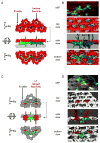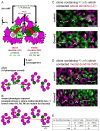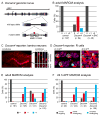Dscam Proteins Direct Dendritic Targeting through Adhesion
- PMID: 26844831
- PMCID: PMC4742784
- DOI: 10.1016/j.neuron.2015.12.026
Dscam Proteins Direct Dendritic Targeting through Adhesion
Abstract
Cell recognition molecules are key regulators of neural circuit assembly. The Dscam family of recognition molecules in Drosophila has been shown to regulate interactions between neurons through homophilic repulsion. This is exemplified by Dscam1 and Dscam2, which together repel dendrites of lamina neurons, L1 and L2, in the visual system. By contrast, here we show that Dscam2 directs dendritic targeting of another lamina neuron, L4, through homophilic adhesion. Through live imaging and genetic mosaics to dissect interactions between specific cells, we show that Dscam2 is required in L4 and its target cells for correct dendritic targeting. In a genetic screen, we identified Dscam4 as another regulator of L4 targeting which acts with Dscam2 in the same pathway to regulate this process. This ensures tiling of the lamina neuropil through heterotypic interactions. Thus, different combinations of Dscam proteins act through distinct mechanisms in closely related neurons to pattern neural circuits.
Copyright © 2016 Elsevier Inc. All rights reserved.
Figures







Comment in
-
Fly Dscams Can Also Help You Find the Right Partners.Neuron. 2016 Feb 3;89(3):423-5. doi: 10.1016/j.neuron.2016.01.021. Neuron. 2016. PMID: 26844824
Similar articles
-
Dscam1 is required for normal dendrite growth and branching but not for dendritic spacing in Drosophila motoneurons.J Neurosci. 2014 Jan 29;34(5):1924-31. doi: 10.1523/JNEUROSCI.3448-13.2014. J Neurosci. 2014. PMID: 24478371 Free PMC article.
-
Dscam-mediated repulsion controls tiling and self-avoidance.Curr Opin Neurobiol. 2008 Feb;18(1):84-9. doi: 10.1016/j.conb.2008.05.005. Epub 2008 Jun 4. Curr Opin Neurobiol. 2008. PMID: 18538559 Free PMC article. Review.
-
Dscam-mediated cell recognition regulates neural circuit formation.Annu Rev Cell Dev Biol. 2008;24:597-620. doi: 10.1146/annurev.cellbio.24.110707.175250. Annu Rev Cell Dev Biol. 2008. PMID: 18837673 Free PMC article. Review.
-
Fly Dscams Can Also Help You Find the Right Partners.Neuron. 2016 Feb 3;89(3):423-5. doi: 10.1016/j.neuron.2016.01.021. Neuron. 2016. PMID: 26844824
-
Homophilic Dscam interactions control complex dendrite morphogenesis.Neuron. 2007 May 3;54(3):417-27. doi: 10.1016/j.neuron.2007.04.013. Neuron. 2007. PMID: 17481395 Free PMC article.
Cited by
-
Natural variation in the regulation of neurodevelopmental genes modifies flight performance in Drosophila.PLoS Genet. 2021 Mar 18;17(3):e1008887. doi: 10.1371/journal.pgen.1008887. eCollection 2021 Mar. PLoS Genet. 2021. PMID: 33735180 Free PMC article.
-
A multi-protein receptor-ligand complex underlies combinatorial dendrite guidance choices in C. elegans.Elife. 2016 Oct 5;5:e18345. doi: 10.7554/eLife.18345. Elife. 2016. PMID: 27705746 Free PMC article.
-
Long live the queen, the king and the commoner? Transcript expression differences between old and young in the termite Cryptotermes secundus.PLoS One. 2019 Feb 13;14(2):e0210371. doi: 10.1371/journal.pone.0210371. eCollection 2019. PLoS One. 2019. PMID: 30759161 Free PMC article.
-
Neural specification, targeting, and circuit formation during visual system assembly.Proc Natl Acad Sci U S A. 2021 Jul 13;118(28):e2101823118. doi: 10.1073/pnas.2101823118. Proc Natl Acad Sci U S A. 2021. PMID: 34183440 Free PMC article.
-
Systematic functional analysis of rab GTPases reveals limits of neuronal robustness to environmental challenges in flies.Elife. 2021 Mar 5;10:e59594. doi: 10.7554/eLife.59594. Elife. 2021. PMID: 33666175 Free PMC article.
References
-
- Edelman GM. Cell adhesion molecules. Science. 1983;219:450–457. - PubMed
Publication types
MeSH terms
Substances
Grants and funding
LinkOut - more resources
Full Text Sources
Other Literature Sources
Molecular Biology Databases

